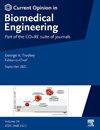微流控和器官芯片方法模拟肿瘤微环境
IF 4.2
3区 工程技术
Q2 ENGINEERING, BIOMEDICAL
引用次数: 0
摘要
肿瘤微环境(tumor microenvironment, TME)是一个复杂的生态系统,除细胞外基质和分泌因子外,还涉及癌细胞、免疫细胞和基质细胞。在这个复杂的生态系统内的相互作用调节肿瘤细胞表型和直接癌症进展,使他们的理解对推进我们的癌症生物学知识和开发创新治疗至关重要。由于标准培养条件无法解释TME的复杂性,因此开发了器官芯片(OOC)技术来满足这一需求。在这里,我们描述了通过控制肿瘤细胞的物理、化学、几何和生物环境来改善体外TME模型的OOCs的最新进展。我们从利用ooc来了解癌症生物学的研究开始,然后描述在TME内测试药物作用的工作。最后,我们讨论了未来的发展途径,这将提高OOCs在各种应用中的兴趣,包括临床测试。本文章由计算机程序翻译,如有差异,请以英文原文为准。
Microfluidic and organ-on-a-chip approaches to model the tumor microenvironment
The tumor microenvironment (TME) is a complex ecosystem that involves cancer cells, immune and stromal cells, in addition to extracellular matrix and secreted factors. The interactions within this complex ecosystem regulate tumor cell phenotypes and direct cancer progression, making their understanding essential for advancing our knowledge of cancer biology and developing innovative treatments. Since standard culture conditions cannot account for the complexity of the TME, organ-on-a-chip (OOC) technologies have been developed to fill this need. Here, we describe the recent advances in OOCs designed to improve in vitro models of the TME by controlling the physical, chemical, geometrical, and biological environment of tumor cells. We begin with studies that leverage OOCs to understand cancer biology, followed by a description of works that test drug effects within the TME. Finally, we discuss future avenues for development that will enhance the interest of OOCs for diverse applications, including clinical testing.
求助全文
通过发布文献求助,成功后即可免费获取论文全文。
去求助
来源期刊

Current Opinion in Biomedical Engineering
Medicine-Medicine (miscellaneous)
CiteScore
8.60
自引率
2.60%
发文量
59
 求助内容:
求助内容: 应助结果提醒方式:
应助结果提醒方式:


